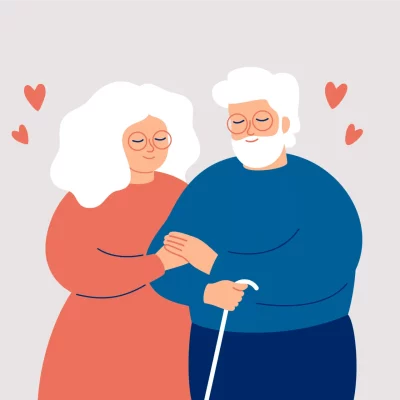Have you ever felt like your partner doesn’t appreciate all the effort and love you put into your relationship? It’s a familiar feeling, but they could be expressing their love in ways that don’t match yours.
Everyone has a different ‘love language’ – how we prefer to receive affection from our partners. Figuring out someone’s love language can help couples improve communication and strengthen their bond. If you’re curious about identifying someone’s love language, read on for some helpful tips!
What Is a Love Language?
The 5 Love Languages concept was first introduced by author Dr. Gary Chapman in his 1995 book, The 5 Love Languages: The Secret to Love That Lasts. This popular self-help book outlines the five ways people tend to express and interpret love – which are referred to as “love languages”: receiving gifts, quality time, words of affirmation, acts of service, and physical touch.
Since its introduction over 25 years ago, the concept of the 5 Love Languages has become a potent tool for couples worldwide. It’s helped countless relationships overcome communication barriers and improve overall satisfaction by helping partners identify their respective love language and how they can best show their partner that they care.
The idea behind the 5 Love Languages is that everyone expresses and receives love differently. Everyone has a unique way that works best for them when communicating emotion and affection. By recognizing that we all have our own unique qualities and distinct preferences when it comes to receiving love, couples can more effectively communicate with each other and build stronger relationships.
What Are The 5 Love Languages?
The concept of the 5 Love Languages has become a powerful tool to help couples recognize their respective love language and how they can best show their partner that they care. People tend to express and interpret love in five different ways – which are referred to as “love languages”: receiving gifts, quality time, words of affirmation, acts of service, and physical touch. Let’s explore each love language in more detail so you can better understand your preferences when expressing love.
Receiving Gifts:
Receiving gifts is a tangible way to show appreciation or affection towards another person. It doesn’t have to be expensive or lavish; even a small gift like flowers or a handwritten note can make all the difference in showing someone you care about them. Those who prefer this type of expression must receive meaningful tokens from time to time.
Quality Time:
Quality time refers to spending uninterrupted time with someone doing something enjoyable together – whether playing board games at home on a rainy day or going out for dinner together on Saturday night. The key here is being fully present with your partner without distractions such as phones ringing or emails pinging. So for those who prefer this type of expression, it’s essential that their partner gives them intentional, undivided attention.
Words of Affirmation:
Words of affirmation refers to verbal expressions of love and appreciation towards your partner. This could be saying, “I love you,” or “You look beautiful today,” or simply expressing gratitude for something they did. While it’s essential to show your partner physical affection, words can go a long way in strengthening the bond between two people. Those who prefer this type of expression, they need to hear positive affirmations regularly.
Acts of Service:
Acts of service is a way of expressing love and appreciation through actions rather than words. This could mean doing the dishes after dinner, taking out the trash before bed, or making breakfast in bed on Sunday morning. It’s important to remember that these acts don’t just need to be related to household chores; they can also include planning a surprise date night or running errands without being asked. Those who prefer this type of expression need their partner to put some effort into helping them with daily tasks.
Physical Touch:
Physical touch refers to affectionate physical contact, including hugs, cuddling, holding hands and more. This is a powerful way to show someone that you care about them without saying a single word. For those who prefer this type of expression, it’s important that they receive meaningful physical contact from those they love.
Ultimately, by recognizing and understanding the 5 Love Languages, couples can better communicate with each other and strengthen their bond. By being mindful of your partner’s love language, you can demonstrate care in ways that will impact them the most. It might sound simple, but if expressed regularly, these small gestures can make all the difference in keeping the spark alive in your relationship!
What Is My Love Language?
When determining which love language you prefer, it’s important to ask yourself what makes you feel most appreciated and to feel loved most. While what you like to receive from your partner can differ from what you give them, understanding your preferences can help solidify the bond in your relationship.
An excellent place to start is by considering the five love languages listed above. Reflect on which type of expression resonates most with you when expressing and interpreting your own love language.
For example, if someone gives you a heartfelt card or text message expressing their appreciation for you, do you feel touched? Or if someone spends an entire evening out with just the two of you focused on each other’s company – do you feel connected to them? Once you’ve identified your preferred love language(s), communicate this with your partner so they know how best to express their affection towards you.
It is important to note that it is common to prefer more than one love language or have different preferences for giving and receiving affection.
For example, you may prefer to receive words of affirmation but also like to give acts of service. It is also possible that you like to give and receive quality time best or that you like quality time and physical touch as your top two.
Knowing how best to show your partner they are loved is essential to any romantic relationship. The more in tune we are with our own needs and preferences when it comes to expressing love – as well as those that our partner has – the more fulfilling our relationships will be.
How Can the Love Languages Help Relationships?
The five love languages are a powerful tool for all types of relationships, from friendships to romantic relationships, and even for connecting with your children. By understanding and recognizing the different love languages, individuals can become more attuned to their own needs and those of their partners or friends, making your loved ones feel seen and known.
For example, suppose someone’s primary love language is physical touch. In that case, they may crave hugs and hand-holding more than words of affirmation or acts of service. With this knowledge, their partner can express their affection through meaningful physical contact, even if that isn’t their default way of showing appreciation.
Similarly, if someone prefers quality time over receiving gifts, spending intentional one-on-one time with them may be more valuable than expensive presents. Knowing how best to show your loved ones you care can help create deeper bonds between two people.
Moreover, the five love languages also offer guidance for connecting with children. For example, suppose a child’s primary love language is quality time. In that case, parents should make sure that they are showing up consistently and carving out time in the day devoted solely to their child. They can also try activities together, such as reading stories or playing board games, allowing them to spend quality time together while still engaging in activities that both parties enjoy.
Additionally, words of affirmation are essential when it comes to parenting – praising a child’s accomplishments or thanking them for working hard on an assignment will boost their self-esteem and show them that they are cared for by their parents and loved ones.
Conclusion
No matter what kind of relationship you have, understanding the five love languages can be a powerful tool for strengthening connections. Whether it’s your partner or your child, taking time to reflect on which type of expression resonates most with you and communicating this to them is essential to any meaningful relationship.
Hopefully, this post helped you answer the question, “What Is My Love Language?” By recognizing our own needs and those that our loved ones have when it comes to expressing affection, we can better foster stronger bonds between two people. Knowing how best to show someone they are cared for can make all the difference in creating fulfilling relationships with those around us.
Sometimes expressing love can be tricky, even if you know your love language. Speaking to a licensed therapist could be beneficial to find the root of the issue and get you to a place where expressing love can be a positive experience.
If you struggle with expressing love or affection or want to talk to someone about relationship issues, we are here to help! Call us or make an appointment to take the first step towards healthy emotional expression.
More on the topic of Relationships:
5 Important Conflict Resolution Steps: Your Guide on Conflict Resolution
Conflict Avoidance in Relationships: What is it and why does it happen?
How To Get Past Resentment In Your Marriage








